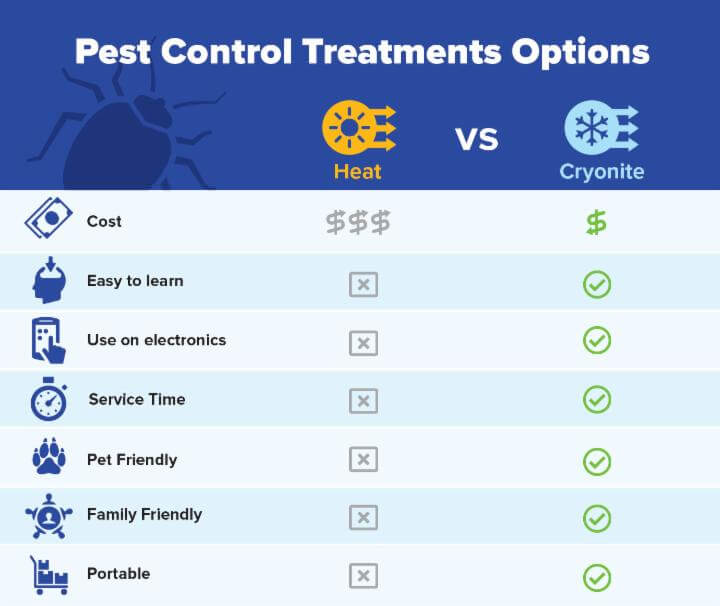When dealing with bed bugs and other pests, pest control companies will often use heat-based pest control treatments. For buildings that can be vacated and will suffer minimal property damage, heat treatments can be an effective solution. However, there are other applications where heat is not the most efficient means to achieve control. In these cases, Cryonite is a good option due to its efficacy, versatility, and convenience.
So, what are all the differences between heat treatments and Cryonite treatments? We list the pros and cons of each below.
Disadvantages
Heat Treatments
Walls or floors that are concrete or if have poor insulation are not ideal candidates for heat treatments. Poor insulation makes it difficult to bring all areas of the room to a lethal temperature.
Another challenge posed by heat is the distribution of heat to the target level into all cracks and voids where insects may be harboring. Heated air needs to be well circulated for an extended period of time to penetrate deeply into cracks, voids, and items within the structure.
Heat treatments are labor-intensive and time-consuming, which adds to the expense of the service. If the entire structure is being treated, all building occupants must vacate the premises during the period of treatment.
Heat sensitive items such as electronics (computers, flat screens, candles, record albums, etc.) and plastics must be protected with thermal blankets or removed from the treatment area. This results in a risk of bringing the infestation back if they are not treated using another method.
Other items, such as vinyl windows and plastic parts of large appliances, are difficult to protect or remove and may be damaged, resulting in costly replacements.
Depending on the temperature and the treatment duration, wood furniture might shrink or crack due to loss of moisture. Since heat penetrates all furniture and areas of the room to be most effective, furniture and other items must frequently move during the heat treatment to assure full coverage.
The initial investment for heat treatments is high. Basic equipment starts at $5,000 and can easily cost up to $50,000 and above. Recouping initial investments in equipment delays the realization of maximum profitability.
Cryonite
Cryonite has few limitations. The CO2 dry ice snow kills on contact and flushes insects hiding within cracks and voids, bringing them into the open where they may be contacted with Cryonite or removed by vacuuming. Like steam, Cryonite is a targeted application. This is a benefit for low to moderate infestations where heating might be considered excessive and time-consuming. However, for heavy infestations in a larger structure, using Cryonite as your primary tool could be time-consuming.
Advantages
Heat Treatments
Heat can be an advantageous strategy for bed bug control if the customer has a lot of clutter and if the target temperature can be reached and maintained promptly. Another advantage is that the entire unit or house can be treated all at once. Assuming the requisite equipment is available depending on the size of the property.
Cryonite
Items removed from a unit during heat treatment may be treated with Cryonite, giving pest control operators the best of both worlds when heat is the more viable primary treatment option. Cryonite is safe to use nearly everywhere. A few expectations apply, including smoke detectors, sprinkler systems, and hot light bulbs.
Residents and their pets can be present during the treatment. Also, there is a reduced risk to furniture or bedding due to the nature of the Cryonite application. When the Cryonite protocol is properly utilized, there is less chance of spreading the infestations to other house or apartment complex areas.
Cryonite is effective for other pest issues such as stored product pests, and cockroaches.
Conclusion
Pest control companies can utilize the Cryonite system for several reasons, among which are:
- A scientifically proven method to kill all life stages of not only bed bugs but other insects.
- The ability to use the unit in a number of different settings such as hospitality, education, Green/LEED buildings, food service, and other pesticide sensitive accounts.
- Cryonite is non-toxic.
- Cryonite can be used while people are present and in all building areas, including electrical boxes.
- Portability.
- Poses less risk to use than heat units with no damage potential to items within structures.
A pest control operator should not rely solely on Cryonite for controlling many pests, especially bed bugs; it is simply one part of an integrated strategy that can make it easier to control challenging pests or work in sensitive accounts. It’s most effective when paired with vacuuming, mattress encasements, and residual products. When used in this manner, it can be an extremely effective way to control an infestation while limiting the resident’s inconvenience and the chance that items may be damaged during treatment.
Contact us today for more information.

